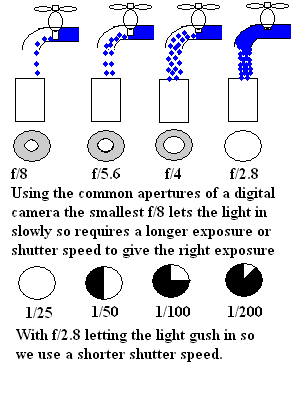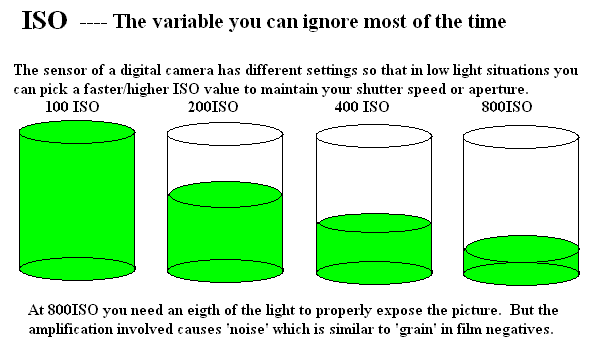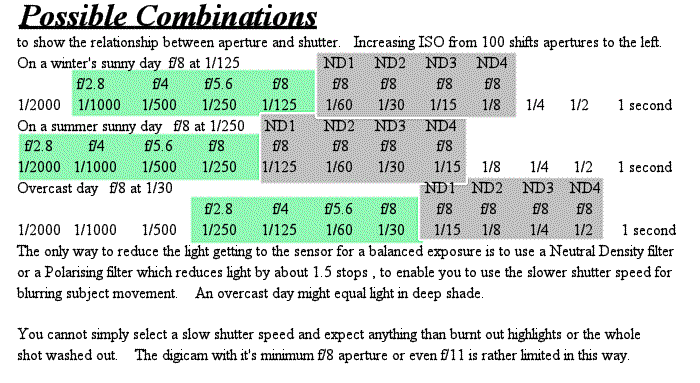Digital
The best way to start is to trust the wonderful circuitry and tools which the makers build into their cameras.
Even the simple point and shoot variety can be bewilderingly complicated. It is often quicker and much easier to know how the camera is reacting to the scene you want to record and 'trick' it into giving you the result you want. Here I am explaining the variables available to you once you venture out of full auto or programme mode ..."P".

Aperture [Iris]
Compared to a film camera's or Digital Single Lens Reflex's lens the average digital has a restricted range of apertures usually extending from f/2.8 to f/8.
The aperture is akin to a tap letting light into the camera. With f/2.8 letting it gush into the camera and f/8 restricting the flow. The principle values shown left each let twice or half as much as the number either side of them. The digital camera is also capable arranging the adjustable iris to create apertures whose values fall in-between those listed. So you might get f/3.2 and f/3.5 between f/2.8 and f/4 . Because the whole set up is so small, serious defects are introduced if smaller than f/8 is attempted.

Aperture Priority 'A' Mode
It is usually recommended that the first mode you should practice with is 'A' aperture priority. In 'A' you merely control the aperture while the camera works out the rest. The most common problem with 'A' is that when light levels are lower the camera dutifully selects a slow shutter speed to match the aperture and you get camera shake/blurred picture. Digitals appear to be rather slow in increasing the sensitivity of the sensor and seem to give a slow shutter speed assuming you know how to handle it.
Supporting the camera with a steady support or tripod.
The shutter speed the camera has selected is usually displayed after it has set itself up when you use 'half-trigger'.
Shutter Priority 'S' Mode
The camera has a much wider range of shutter speeds which permit you to operate in a wide range of light levels from moonlight through to sunlight. With adequate support when the camera picks a slow shutter speed ... longer than 1/50 second unless you are using the telephoto end of your zoom.
But they have to be matched to the aperture and you find you have a limited range of options. Diagram 4 shows likely options available in bright sunlight, winter sunlight and overcast conditions [Green}.
The only way you can extend the range is to use Neutral Density filters [Grey} to reduce the light entering the camera. Even then in bright sunlight you do not get a very slow shutter speed unless you are working in the shade.

ISO Sensor/film Speed
With the increase in the amplification of the signal from the sensor what is known as noise appears, similar to grain in film, and spoils the smooth texture of skin-tones, flower petals and is most noticeable in shadow areas. Some people are very sensitive to 'noise' while others accept it as the price we pay for being able to take shots in low light conditions with high ISO settings.
It also appears when shutter speeds of less than around 1/15 are used. Some cameras are better than others in not being affected by noise.
If you have not got a firm support for the camera when it picks a slow shutter then one option is to increase the ISO setting.

This table shows that for a given light condition you have a choice of aperture/shutter combinations shown in green. Shooting in the shade would move the options to the right by one or two shutter speeds. In the top scale, winter sunny day, from 1/125 down to 1/30 shutter at f/8. [f/5.6 at 1/60, f/4 at 1/125, and f/2.8 at 1/250]
One problem in buying ND filters is that there are different ways of describing their strength or opacity. I suggest you buy one or two of the strongest you can find which may give you a 4 stop reduction in light entering the camera. Discuss it with the retailer as to how much reduction each filter gives you. Another way to reduce light is to use a Polarising filter which has a strength of about 1.5 stops. The ND filter just cuts light and doesn't affect the colour, the Polariser can change the colour. Emphasizing the blue of the sky and reducing reflections from reflective surfaces, metal, water etc.
Further on ........What is Depth of Field?
Being prepared ....
How do we use the shutter speed for good effect? .....How do we use the aperture? ........